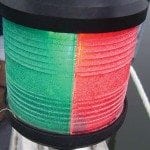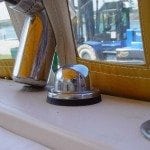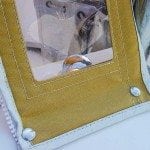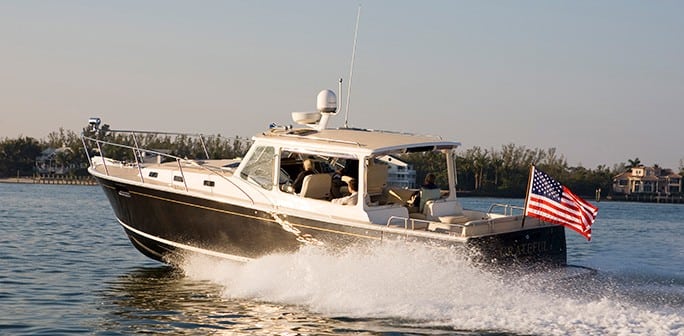Proper navigational lighting is crucial for safe, legal boat operation at night or during times of reduced visibility. As a marine surveyor, many of the vessels I inspect fail to comply with mandated navigational lighting requirements. Many of these problems are maintenance or owner-induced issues such as burned-out bulbs, broken wires and lights blocked by equipment installations; however, an alarming number of violations are caused by improper manufacturer installation. It appears that some manufacturers either do not have a complete understanding of the navigation rules governing installations or they miss the bare minimum requirements at the expense of the end user. Regardless of whether the manufacturer or a previous owner causes installation problems, it’s the boat owner’s responsibility to ensure their boat complies with the rules.
All boats must have the required navigation lights while operating at night or during times of reduced or restricted visibility such as in fog or heavy rain. Vessels 16 feet in length or greater must have properly installed navigation lights and an anchor light that must be operational separate from the running lights.
Required navigation light configurations are based on factors such as vessel length, method of propulsion or any special activity it’s engaged in (trawling, towing, etc.). The type, arc and color of navigation lights allow cruisers to determine a vessel’s size, propulsion and whether it’s anchored or moving (and if so, its course). For example, if you look over the bow and see a red light followed by a white light you can assume another boat is crossing your path from starboard to port and that it has the right of way depending on distance. A single white light that’s visible 360 degrees indicates an anchored vessel.
The first step in determining if your vessel is compliant with lighting regulations is to consult a copy of USCG COMDTINST M16672.2D, aka the “Rules of the Road”. Purchase a copy or view it for free online at navcen.uscg.gov/pdf/navrules/navrules.pdf.
Once you’ve consulted the Rules of the Road and determined that your navigation lights meet the minimum requirements, the next step is a physical inspection to make sure they’re properly installed and operational. Start by turning on the running lights and then the anchor light, verifying in turn that each powers up and meets the visibility requirements mentioned in the Rules of the Road. Look for issues such as the placement of equipment (dinghies, antennas, etc.) that could block visibility, burned out bulbs and poor lighting installations. A good example of the latter would be a masthead light that effectively blinds you when operating the vessel from the upper helm or fly bridge.
Sailboat owners may find it easier to verify the operation of mast-mounted navigation and anchor lights at night from the dock when they’re more easily visible. Next, take a good look at the lights themselves. Are the lenses clear or have they become “frosted” due to UV damage? How bright are the lights? Dim lights can be caused by installation of the wrong type of bulb, a poor quality light fixture or corroded electrical contacts and switches.
Distance visibility—how far your navigational lights can be seen—is crucial and can easily be a case where meeting the letter of the law doesn’t necessarily mean the spirit of the law has been satisfied. I’ve seen installations designed to meet the minimal requirements under perfect conditions—clear weather, minimal wave action, level boat—but they fail miserably in less than ideal conditions, which are the very times you want to make sure you’re seen. Problems range from poor location of the navigation lights—flush mounted sidelights in the hull below the rub rail are a good example of this—to the lights themselves, which are often too small or simply poor quality to begin with.
Don’t be afraid to relocate factory-installed navigation lights to better comply with requirements or even replace them with brighter, more robust units. Light emitting diode (LED) fixtures have become a popular choice in recent years due to advantages such as longer life (up to 100,000 hours in some cases), less power consumption, sealed construction (eliminating corrosion), and non-susceptibility to damage from shock or vibration.
Do not, however, simply swap your incandescent navigation light bulbs with LED replacements. Navigation light fixtures are approved for use as a unit (i.e. bulb and fixture together), and simply swapping out the bulb of your current fixture does not mean the new combination will also comply with regulations. Once you’ve verified everything is in good working order, record the types of bulbs required for all navigation lights and ensure you have plenty of spares on board. Finally, be sure to include checking the operation of all navigation lights as part of you pre-departure checklist. It only takes a moment and you’ll be doing yourself and everyone else on the water a favor.
Buyer Beware
All boat owners love pretty lights, but it’s important to ensure decorative light installations can’t be mistaken for navigation lights or impair the visibility of properly placed navigation lights. Decorative lighting also should not interfere with your ability to maintain a proper lookout. Haphazard installation of additional lighting must be avoided or else violations may occur. For example, blue LED lights under water can appear to be flashing if wave action is present, giving the appearance of flashing blue lights that are only authorized for law enforcement vessels.
Some manufacturers offer less expensive navigation lights that fail to meet certification requirements, which make them a tempting choice for the uninformed buyer. Use of lights that do not provide the proper characteristics of regulation lighting such as chromaticity, luminous intensity or cut-off angles could result in fines or even cause an accident. Ensure each navigation light you purchase contains the following information on the light or its packaging:
• USCG Approval 33 CFR 183.810
• MEETS ABYC A-16 or equivalent
• TESTED BY (an approved laboratory)
• Name of the light manufacturer
• Model number
• Visibility of the light in nautical miles
• Date on which the light was type-tested
• Identification and specification of the bulb used in the compliance test
— By Frank Lanier, Southern Boating Magazine October 2016

















